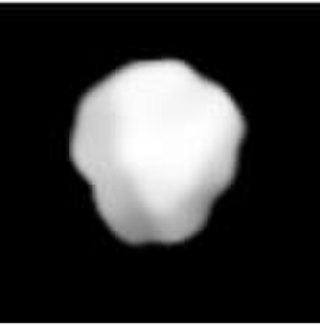11 Parthenope
main-belt asteroid From Wikipedia, the free encyclopedia
Parthenope[7] (minor planet designation: 11 Parthenope) is a large, bright main-belt asteroid.
 | |
| Discovery | |
|---|---|
| Discovered by | Annibale de Gasparis |
| Discovery site | Naples Obs. |
| Discovery date | 11 May 1850 |
| Designations | |
| MPC designation | (11) Parthenope |
| Pronunciation | /pɑːrˈθɛnəpiː/[1] |
Named after | Parthenopē |
| Main belt | |
| Adjectives | Parthenopean /ˌpɑːrθənəˈpiːən/, Parthenopian /pɑːrθəˈnoʊpiən/[2] |
| Orbital characteristics[3] | |
| Epoch 13 January 2016 (JD 2457400.5) | |
| Uncertainty parameter 0 | |
| Observation arc | 60281 days (165.04 yr) |
| Aphelion | 2.69837 AU (403.670 Gm) |
| Perihelion | 2.20671 AU (330.119 Gm) |
| 2.45254 AU (366.895 Gm) | |
| Eccentricity | 0.10024 |
| 3.84 yr (1402.9 d) | |
Average orbital speed | 19.02 km/s |
| 330.520° | |
Mean motion | 0° 15m 23.81s / day |
| Inclination | 4.62985° |
| 125.567° | |
| 196.005° | |
| Earth MOID | 1.19227 AU (178.361 Gm) |
| Jupiter MOID | 2.54174 AU (380.239 Gm) |
| TJupiter | 3.483 |
| Physical characteristics | |
| Dimensions | c/a = 0.88±0.05[4] |
Mean diameter | 149±2 km[4] 153.3±3.1 km (IRAS)[3] |
Mean radius | 76.665 ± 1.55 km |
| Mass | (5.5±0.4)×1018 kg[4] 6.15×1018 kg[5] |
Mean density | 3.2±0.27 g/cm3[4] 3.28±0.20 g/cm3[5] |
Equatorial surface gravity | 0.0578 m/s2 |
Equatorial escape velocity | 0.0941 km/s |
| 13.7204 h (0.57168 d)[3] | |
| 0.187 (calculated)[4] 0.1803±0.007[3] | |
| Temperature | ~174 K |
| S-type asteroid[3] | |
| 8.68[6] to 12.16 | |
| 6.55[3] | |
| 0.178" to 0.057" | |
Parthenope was discovered by Annibale de Gasparis on 11 May 1850. It is the second of his nine asteroid discoveries. It was named after Parthenopē, who was one of the Sirens in Greek mythology. Parthenopē founded the city of Naples.[8] Two symbols were proposed for Parthenope: a fish and a star (![]() ) and later a lyre (
) and later a lyre (![]() ). Both are not used anymore.
). Both are not used anymore.
On 6 August 2008, during a perihelic opposition, Parthenope had an apparent magnitude of 8.8.
In 1988, a UH88 telescope at the Mauna Kea Observatories looked for it, but they never found it.[9]
It has a rotation period of 13.722 ± 0.001 hours, Its brightness is anywhere from 0.10 ± 0.0s in magnitude.[10][3]
Mass
In 2007, Baer and Chesley discovered that it is of 6.3×1018 kg.[11] It had a density of 3.3 g/cm3.[11] In 2008, it was found that it could have a mass of 6.15×1018 instead.[5] In 1997 and 2001, it was thought that that it was 5×1018 kg and had a density 2.7 g/cm3.[11]
Related pages
Notes
Other websites
Wikiwand - on
Seamless Wikipedia browsing. On steroids.
